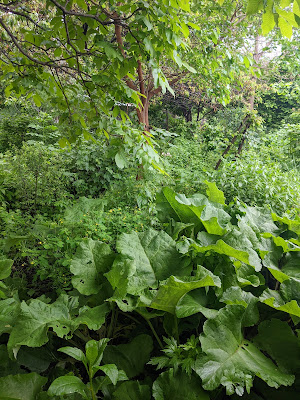Welcome to part 2 of a series where I'll be posting some observations and experiences about the various plant species from our forest gardens and regenerative landscapes, as well as interesting plants and polycultures from around the world. We'll be featuring plants from different layers of the forest garden, presenting some established polycultures, and providing some suggestions about how to design, build and manage forest gardens and regenerative landscapes.
Forest Garden Plants
Lower Canopy Layer - Zanthoxylum piperitum - Japanese Pepper Tree makes a great lower canopy tree in the forest garden, a relatively small tree that is tolerant of shade and cast little shade itself due to the thin canopy. we have found Rubus fruticosus cv. - Blackberry and Ribes nigrum cv.- Blackcurrants both grow well under these trees.
Shrub Layer - Prunus spinosa - Sloe grows wild in our gardens forming thickets expanding into the meadows from the woodland edge. The thickets provide excellent habitat for Longtail, great, coal, and blue tit, along with various warblers that are often flying in and out of the thicket, probably feeding from the invertebrates but possibly some species looking for nesting sites.
The flowers, if pollinated and fertilized, will go on to form small purple fruits that are used to make Sloe Gin a red liqueur made by steeping sloe berries in gin and adding sugar. The sloe berries are picked after the first frost of the year, which helps to break down the skin and release the juice, before being steeped in the gin. The end result is a sweet and tart liqueur that is often enjoyed as a digestif or used in cocktails.
Herb Layer - Arctium lappa - Greater Burdock is a large-leaved plant that dominates a wild patch under a walnut tree in our back garden. They make excellent biomass plants and, when in flower are highly attractive to a variety of invertebrates. The broad leaves are a favorite sheltering spot and food for snails and the inclusion of these plants around a vegetable patch will serve as a good decoy and make it easy to collect the snails to prevent them from venturing into the vegetables. The large fleshy taproot is also edible, best harvested from 1-year-old plants in the Autumn.
Ground Layer - Delosperma cooperi - Pink Carpet makes a great ground cover around the forest garden. The plants can tolerate partial shade and we've been planting under new fruit trees and for bordering pathways. 30 cm spacing between plants will form a complete cover within the second growing season and the plants will continue to spread outward via layering. The photos below show the ground cover under Prunus armeniaca - Apricot with Tanacetum vulgare - Tansy on the left.
It's interesting to note that The plant contains the hallucinogen chemicals DMT and 5-MeO-DMT, which can be extracted from the leaves. The concentration of these chemicals varies over the year. The content of 5-MeO-DMT rises during the summer and the content of DMT instead rises during the winter.
Regenerative Landscape Design - Online Interactive Course
Want to learn how to design, build and manage regenerative landscapes? Join us on our Regenerative Landscape Design - Online Interactive Course. We look forward to providing you with the confidence, inspiration, and opportunity to design, build and manage regenerative landscapes, gardens, and farms that produce food and other resources for humans while enhancing biodiversity.
You can find the course details here and at the moment we have a $350 ( 20%) discount for full enrollment to the course. Just use RLD2024 in the promo code section of the registration form to receive your discount.
Some of the best broadscale polycultures I've seen include the date palm oases of Al Hamra, Oman, where a tremendous amount of food is grown in a wonderfully biodiverse environment in a Subtropical desert climate.
Cultivation practices in Al Hamra (Jebel Shams region) are incredible. Dates are the main crop with several varieties of date palms grown, including Khalas, Fardh, Hilali, Khuneizi, and others. The Khalas variety, in particular, is highly prized for its taste and is indeed the most delicious date I've ever tried.
Planted among the dates are Pomegranate, Figs, Mango, Banana, and Citrus with cereal in the understory and wild herbs often encouraged around the edges of the beds.
Support Our Project
If you appreciate the work we are doing you can show your support in several ways.
Become a member of the Bloom Room. A $70 annual or $7 per month subscription to our Substack provides you with access to live sessions, design tutorials, a members forum and more, see details here.
Make a purchase of plants or seeds from our Nursery or Online Store
Joining us for one of our Practical Courses or Online Courses
Comment, like, and share our content on social media.
If you appreciate the work we are doing you can show your support in several ways.
Become a member of the Bloom Room. A $70 annual or $7 per month subscription to our Substack provides you with access to live sessions, design tutorials, a members forum and more, see details here.
Make a purchase of plants or seeds from our Nursery or Online Store
Joining us for one of our Practical Courses or Online Courses
Comment, like, and share our content on social media.


.jpg)
.jpg)

.jpg)

.jpg)
.jpg)
.jpg)
.png)


.JPG)
.JPG)



.jpg)


.jpg)
.jpg)



No comments:
Post a Comment